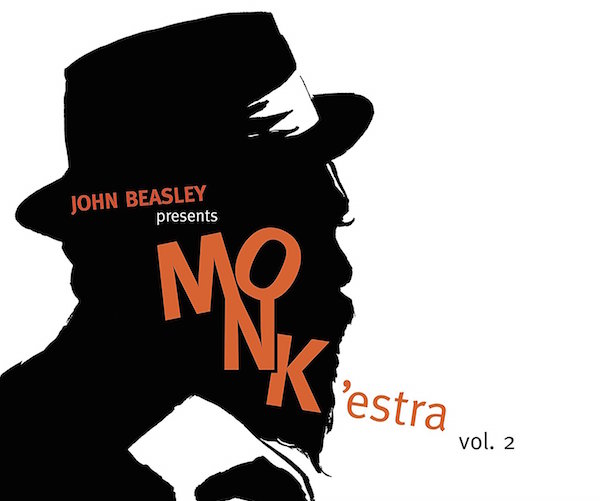Jazz CD Review: “MONKestra, Volume Two” — Reinventing Monk
John Beasley and his big band doesn’t tame Monk or make him uncharacteristically pretty.
John Beasley Presents MONKestra, Volume Two (Mack Avenue)

By Michael Ullman
Now 56, pianist-composer John Beasley has been writing arrangements since he was a high school student in Louisiana, when at age 17 he arranged a piece for the University of North Texas jazz band that earned him a scholarship to the Stan Kenton summer camp. His parents were musicians: according to his official bio, he learned to play trumpet, oboe, drums, and saxophones as needed to fill out the personnel in his mother’s big band. When he was 17, he was offered, and declined, a scholarship in oboe playing at Juilliard. He stuck with piano, and started recording in the early ’80s. I first heard him as a sideman to Freddie Hubbard, but he was also briefly with Miles Davis. (As far as I can tell, the only record of his performances with Miles is the live version of “Mr. Pastorius” found on the LP Live Around the World). Much more recently, his album Positootly! was nominated for a Grammy. He’s written or played for movies (Spectre, but also Finding Nemo!), and often for television. (One of his jobs was to write the music for Sports Illustrated Swimsuit: 50 Years of Beautiful, which was evidently a TV show. I wonder if anyone listened.) He’s broad in his tastes: at various times he has been musical director for Carly Simon, Steely Dan, and Queen Latifah.
More recently, he’s been conducting a 15 piece orchestra dedicated to playing the music of Thelonious Monk. He isn’t new to Monk. When he was in his twenties, he recorded Thelonious under the direction of bassist Buell Neidlinger, In 1993, he recorded Monk’s “Skippy” for Windham Hill: elsewhere he has recorded the inevitable “Round Midnight,” and also, among other pieces, “Straight No Chaser.” Last year, when MONKestra Volume One was released, though, he showed how deeply immersed in Monk’s music he has been: sufficiently immersed to seemingly change everything without losing the thread of Monk’s remarkable vision. With its shifting textures, and sometimes far-ranging re-imaginings of Monk, the album managed to pull off quite a trick — it was respectful and innovative. The disc was also beautifully recorded by a leader interested in sonorities as well as melodic lines.
Now MONKestra Volume Two has been released and I for one am happy the second shoe has dropped. Volume One featured invited guests such as Gary Burton on “Epistrophy” and, more surprisingly, Gregoire Maret on harmonica. Volume two includes violinist Regina Carter’s drawling statement of Crepuscule with Nellie‘s beautiful theme, her deliberately lazy phrases punctuated by high, startlingly loud (and precise) figures from the reeds that are part of Monk’s original melody. (Monk’s pieces tend to have call and response embedded in them.) In the next iteration it’s the brass players who answer Carter’s violin. Rather than try to soften Monk’s contrasts, Beasley emphasizes them in orchestrations that are rich and broadly textured.
Perhaps startling juxtapositions are his secret. On Volume One, he introduced “Round Midnight” with a bright snare drum figure: there’s a backbeat throughout, but murmuring electronic sounds come in before Beasley plays a casual version of Monk’s most famous tune. It’s Monk and it’s not. He seems to be pointing out things in Monk that we hadn’t previously noticed. On Volume Two Beasley turns “Criss Cross” into a Latin tune featuring Pedro Martinez. His orchestrations are always fascinating, the performances both precise and relaxed. Beasley has the low brass gently state the main theme of “Light Blue,” answered by a woodwind choir aided by what sounds like a couple of clarinets. Then the sound of a pipe organ intrudes: it brings in the weepiness of afternoon soap operas. Somehow it all works. Refreshingly, Beasley doesn’t only take on the well-known Monk: the album starts off with “Brake’s Sake” from the Columbia album optimistically entitled It’s Monk’s Time. Beasley’s version includes a rap that glorifies Monk’s genius and the challenges that he faced. “Dear Ruby,” on the other hand, is a straightforward rendition of “Ruby My Dear,” here played gorgeously by the band and sung by Dianne Reeves.
Beasley doesn’t tame Monk or make him uncharacteristically pretty. (One of the compositions on Volume 2 is “Ugly Beauty.”) He’s deferential, but also innovative in sharp ways that Monk fans, and fans of big band music, should appreciate. Volume 2’s session is vividly recorded. I am very much looking forward to Volume Three.
Michael Ullman studied classical clarinet and was educated at Harvard, the University of Chicago, and the U. of Michigan, from which he received a PhD in English. The author or co-author of two books on jazz, he has written on jazz and classical music for The Atlantic Monthly, The New Republic, High Fidelity, Stereophile, The Boston Phoenix, The Boston Globe, and other venues. His articles on Dickens, Joyce, Kipling, and others have appeared in academic journals. For over 20 years, he has written a bi-monthly jazz column for Fanfare Magazine, for which he also reviews classical music. At Tufts University, he teaches mostly modernist writers in the English Department and jazz and blues history in the Music Department. He plays piano badly.
